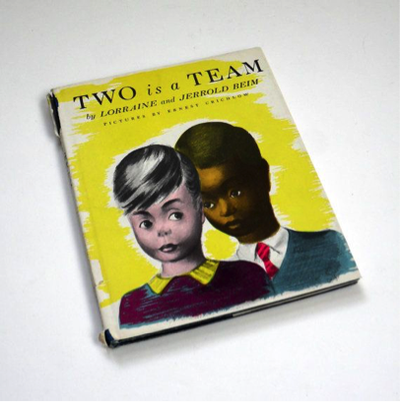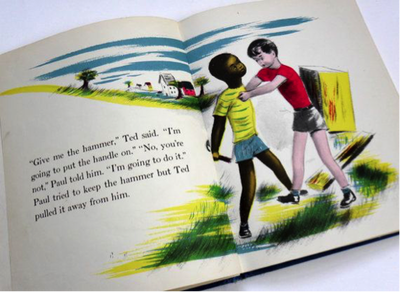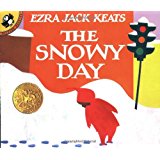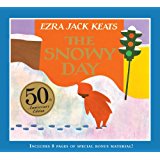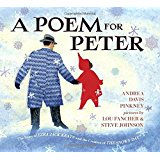The Snowy Day by Ezra Jack Keats (New York: Viking, 1962) won the 1963 Caldecott medal. It received a lot of attention because of its multicultural protagonist, Peter. While Peter is often thought of being the first child of color illustrated in an American picture book, he is not. According to Kathleen T. Horning, the director of the Cooperative Children’s Book Center of the School of Education at the University of Wisconsin–Madison, “there were really early negative portrayals, such a the Epaminondas series (c.1907) by Sara Cone Bryant and Little Black Sambo (1900), by Helen Bannerman which wasn’t really African American but used a lot of stereotypes familiar in the U.S. The first positive portrayal of a child of color in a picture book was Tobe (1939) by Stella Gentry Sharpe. It was followed by Two is a Team (1945) by Lorraine and Jerrold Beim, and My dog Rinty (1946) by Ellen Tarry and Marie Hall Ets. Tobe and My Dog Rinty were both illustrated with photographs. Two is a Team was illustrated by Ernest Crichlow, making it the first picture book illustrated by an African-American artist.” This story has an African American protagonist who, after a disagreement about building a coaster with his white friend, ends up learning the value of working together.
The Snowy Day was the first book that Keats wrote himself and he wanted to do a different type of illustration in it than he had done in his previously illustrated books for other authors. He developed a collage art style by adding small pieces of patterned paper to his painted backgrounds. This was a real divergence from all his earlier work, and the beginning of the style he used for all his books thereafter. The Snowy Day remains an important book in the history of children’s literature because it gave a face to children who had, up until its publication, not really been well represented in children’s picture books. The fact that Peter went on to became a character in many of Keats’ later books, makes him beloved to many children. Here they were! In books!
I have used this anniversary edition with primary students K-2 and have shared the pictures and information from the back matter with them. They are surprised that Ezra Jack Keats is white, and curious about the newspaper clippings of the little black boy who became Peter in the book. Although the 50th anniversary was cause for celebration, when The Snowy Day was first published some critics questioned whether a Jewish man had the right to tell a story about an African American child. The controversy was “devastating” to Keats. He had grown up in a poor immigrant family and changed his last name from Katz to Keats after years of anti-Semitism. Keats said, “I don’t like to emphasize the race thing, because what’s really important is the honesty (Keats 36).”
Andrea Pinkney’s book, A Poem for Peter, illustrated by Lou Fancher & Steve Johnson (New York: Viking, 2016) is a picture book biography of Ezra Jack Keats written in lyrical narrative. Pinkney flawlessly weaves a poetic introduction of Peter around the facts and story of Ezra Jack Keats’ life. Pinkney’s book provides the background for the personal journey Keats went on in order to bring Peter to life.
Bright as the day you came onto the page.
From the hand of a man who saw you for you.”
Keats was the youngest of three children born to Jewish Polish immigrant parents who came to America in the beginning of the 20th century.
“The dark heel of Discrimination
dancing in the streets
of what was their new home:
East New York,
Brooklyn’s poorest part of town, in 1916,
when Jacob (Jack) Ezra Katz
was born.”
On the next page, Andrea Pinkney gives the reader something to think about.
oh, when it snowed!
Nature’s glittery hand
painted the world’s walls a brighter shade.
Snow made opportunity and equity
seem right around the corner.
Because, you see, Snow is nature’s we-all blanket.
When Snow spreads her sheet, we-all glisten.
When Snow paints the streets, we-all see her beauty.
Snow doesn’t know who’s needy or dirty
or greedy or nice.
Snow doesn’t choose where to fall.
Snow doesn’t pick a wealthy man’s doorstop
over a poor lady’s stoop.
That’s Snow’s magic.”
Keats’ life story continues to be told through Pinkney’s lyrical verse. She offers the reader much to think about in her choice of words - “meager”, “battered flat”, “unutterable thing”, “impractical”, “decent wage”, “hard knocks”, “bleaker shade of gray”, “deep-blue darkness”, “cocoa sprite”, “true jubilation”, “ice-paced intolerance” “narrow-minded branches”, and many others.
Keats rearranges his name from Jacob (Jack) Ezra Katz to Ezra Jack Keats after World War II when he encounters signs, “No Jews Need Apply”. He begins to understand that discrimination means to be different, leading the reader to Keats’ fascination of the newspaper clippings of the little brown boy and of bringing that child to life, some twenty years later. When the biography comes to Keats’ writing and illustrating his own book, “brown-sugar boy” Peter is born. “The time had finally come. It was 1962. Ezra Jack Keats dared introduce us to you.”
Pinkney continues to tell Keats’ story, but in each phase of the telling, she brings Peter’s story closer to being told. Two of my other favorite illustrations in this book are near the end after Ezra and Peter are a team. There’s a double page spread with a tree filling the middle of the page through the gutter, and under the tree a man in blue coat and a little boy in a red snowsuit, holding hands, are walking into the book. The same two figures are also on the front cover, making this page “the magic page”. The following page is a door, flung wide open, with collage picture cutouts from all of Keats’ books spilling out – a blue chair, a hat, snowflake endpapers, a dog (Willie), a teddy bear, and more.
A face.
A voice.
Ezra Jack Keats gave us eyes to see.
Let us celebrate the making
of what it means to be.
He dared to open a door.
He awakened a wonderland.
He brought a world of white
suddenly alive with color.
Brown-sugar child,
when you and your hue
burst onto the scene,
all of us came out to play.
Together,
Flapping our wings,
Rejoicing, in a we-all blanket of wheeee!
Thanks to Ezra Jack Keats,
we can all be.
As bright as Snow’s everlasting wonder.”
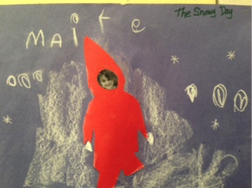
I emailed Andrea after I finished reading A Poem for Peter and said that I thought she should make an audio recording of this book. She shared with me an NPR Interview she did where she does read a portion of A Poem for Peter. This book begs to be read aloud!
Here’s the link: 'A Poem For Peter' Recalls One Unforgettable 'Snowy Day': NPR
At right is an activity you might like to do with your classes. This was an art project that my primary students did in conjunction with our art teacher. I saw this idea in my granddaughter’s kindergarten class last winter.
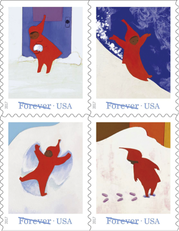
Keats, Ezra Jack. The Snowy Day. 1962. 50th ed., New York, Viking, 2011.
Pinkney, Andrea. “Peter’s Awakening.” Received by the author, 8 Jan. 2017.

